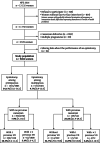Influence of the maternity unit and region of delivery on episiotomy practice in France: a nationwide population-based study
- PMID: 36852493
- PMCID: PMC10008350
- DOI: 10.1111/aogs.14522
Influence of the maternity unit and region of delivery on episiotomy practice in France: a nationwide population-based study
Abstract
Introduction: Our objective was to identify factors associated with episiotomy practice in France, in particular, characteristics of the maternity units and regions of delivery.
Material and methods: We performed a national cross-sectional population-based study in all French maternity units in 2016 including 9284 women with vaginal delivery. Our outcome was the performance of an episiotomy. After stratification for parity, associations of episiotomy practice with individual and organizational characteristics and the region of delivery were estimated with multilevel logistic regression models. The variability in maternity unit episiotomy rates explained by the characteristics studied was estimated by the proportional change in variance.
Results: A total of 19.9% of the women had an episiotomy. The principal factors associated with episiotomy practice were maternal and obstetric and delivery in a maternity unit with <2000 annual deliveries. After adjusting for individual, obstetric and organizational characteristics, the practice of episiotomy was strongly associated with women's region of delivery. Additionally, women's individual characteristics did not explain the significant variability in episiotomy rates between maternity units (P < 0.001) but maternity unit characteristics partly did (proportion of variance explained: 7.2% for primiparas and 13.6% for multiparas) and regional differences still more (18% and 30.7%, respectively).
Conclusions: Episiotomy practices in France in 2016 varied strongly between maternity units, largely due to regional differences. Targeted actions by the regional perinatal care networks may reduce the national episiotomy rate and standardize practices.
Keywords: associated factors; episiotomy; maternity units; organizational characteristics; regions; variability.
© 2023 The Authors. Acta Obstetricia et Gynecologica Scandinavica published by John Wiley & Sons Ltd on behalf of Nordic Federation of Societies of Obstetrics and Gynecology (NFOG).
Conflict of interest statement
The authors have stated explicitly that there are no conflicts of interest in connection with this article.
Figures
References
-
- Tiberon A, Carbonnel M, Vidart A, Ben Halima M, Deffieux X, Ayoubi JM. Risk factors and management of persistent postpartum urinary retention. J Gynecol Obstet Hum Reprod. 2018;47:437‐441. - PubMed
-
- Axelsson D, Brynhildsen J, Blomberg M. Postpartum infection in relation to maternal characteristics, obstetric interventions and complications. J Perinat Med. 2018;46:271‐278. - PubMed
Grants and funding
LinkOut - more resources
Full Text Sources



